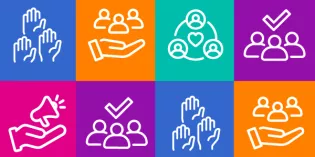This resource was published in May 2025 as part of our project to support children and young people's voice in their epilepsy care and service - find out more about this programme and explore more resources in the related content box.
Where to begin?
It will help to be realistic about your capacity and to have a clear focus. Remember the most powerful way of creating a listening and engaging culture starts with listening to children and young people about their own care. Not having a voice in their own care is the issue children and young people most commonly raise as a concern. This can be achieved with small steps, using quality improvement methods, which can make a big difference to children and young people.
If you have a little more time, you can start to get more creative about ways to ask for feedback about how to improve your service.
If you can ringfence even more time or find additional resources, support, joint working or capacity, then you can develop longer term projects in which children and young people can get more actively involved in shaping your service.
In the Audience and Influence section, you will see case studies from some of the services that took part in this project. These case studies might be useful to give you ideas of activities you could do. Alongside the case studies you will see we have shared ideas for things you can do and have lots of tips, tools and practical ideas that will help.
What helps, or can hinder, a listening and engaging culture?
The epilepsy services that took part in our pilot programme shared some of the challenges that can stall or halt efforts to get participation work off the ground and how they overcame them.
We were told that, when resources and time are stretched, engagement activities to hear children and young people's voice may be paused. This is despite everything we know about the importance of listening to children for their own safety, empowerment and insights into our services.

Tips from epilepsy services
- Build your support network
-
- Reach out to colleagues, management and potential supporters or partners early in the process. This can open up new collaborations, resources and a receptive audience for children and young people’s feedback:
- People to speak with are:
- Your team.
- Senior leaders, management.
- Integrated care boards.
- Youth services, youth participation networks, Local Authority public health teams, local networks for parents / carers of children with SEND, RCPCH &Us.
- Unlock extra resources
-
- Hospital charities
- In-kind support from your network (peer support, venues, facilitation support)
- Include engagement as part of your Quality Improvement work – there may be ways to free up staff time or resource through this.
Download the Time and resources ideas below to how you might use the resources you have.
- Build your network of children, young people and their families
-
- Specialist Epilepsy nurses spoke with children, young people and families, using the personal touch to getting people on board which made a difference. It felt much more successful than a flyer or email
- Create opportunities where families can meet, have fun or children and young people can create something they feel proud of
- Use asset-based approaches – what are the skills, talents and ideas that children, young people and families have, rather than what are their problems. Focus on making a change together
- Don’t forget to invite siblings and friends! It is important that the groups are mixed as this builds wider community understanding and learning
- Have an open-minded and enthusiastic approach
-
- Many of the Epilepsy services set out on this journey with an idea about what they imagined children and young people would want to see changed. Often, they were very surprised that children, young people or their families had very different priorities!
- Don’t make assumptions about what children, young people and families are finding challenging
- Let them help come up with solutions and work with them on these
- Listen with an open heart.
Download the worksheet below to talk through in your teams to get started on these areas.
Topics that might be important to children, young people and their families
In our epilepsy innovation labs, children, young people, parents and carers raised the following issues, which may give you a flavour of what's important to your patients.
- My individual care plans
- How information is communicated to me, when, and how to make sure it is not overwhelming – especially information about SUDEP
- What information my friends and siblings need to know
- What information my wider community need to know so they can support me to live my life fully
- Destigmatising epilepsy
- The importance of peer support (for children, young people and parents and carers)
- What helps me to open up and have a voice in my clinical appointments
- What it feels like to come to your service! What the journey or waiting room is like, how does it make me feel before I come into an appointment to be in the waiting room
- How I feel about my care plan and why it might be hard to stick to it
- medication – side effects, media information, supply, communication between epilepsy teams, GPs and pharmacists
- What support and information I need as I transition into adulthood
- The difficulties navigating the system (especially when there is shared care plan arrangements)
- The importance of siblings and friends in supporting me with my epilepsy and what support they might need in return.










